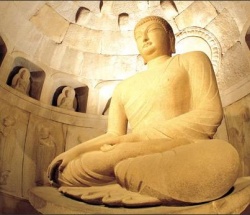The Eight Great Noble Thoughts and Papanca (proliferation) and Nippapanca (non-proliferation) by Bodhicarini Upasika Jayasili Jacquetta Gomes
The Eight Great Noble Thoughts and Papanca (proliferation) and Nippapanca (non-proliferation)
By Bodhicarini Upasika Jayasili Jacquetta Gomes BGKT Buddhist Group of Kendal (Theravada) England UK
Updated 12th September 2015
- “Mankind delights in the diffuseness of the world, the Perfect Ones are free from such diffuseness.” ::(The Dhammapada Verse 254)
- (Source: Buddhist Dictionary: Manual of Buddhist Terms and Doctrines. Nyanatiloka Maha Thera)
Attha-maha-purisa Vitakka
1. Appicchassayam Dhammo, nayam Dhammo mahicchassa.
2. Santutthassayam Dhammo, nayam Dhammo asantutthassa.
3. Pavivittassayam Dhammo, nayam Dhammo Sanghanikaramassa.
4. Araddhaviriyassayam Dhammo, nayam Dhammo kusitassa.
5. Upatthitasatissayam Dhammo, nayam Dhammo mutthassatissa.
6. Samahitassayam Dhammo, nayam Dhammo asamahitassa.
7. Pannavato ayam Dhammo, nayam Dhammo duppannassa.
8. Nippapancaramassayam Dhammo nippapancaratino nayam Dhammo papancaramassa papancaratino.
Eight Great Noble Thoughts
1. This Dhamma is for reducing desire, not for increasing desire.
2. This Dhamma is for increasing contentment, not for increasing discontentment.
3. This Dhamma is for cultivating seclusion, not for becoming sociable.
4. This Dhamma is for becoming energetic, not for becoming lazy.
5. This Dhamma is for developing mindfulness, not developing unmindfulness.
6. This Dhamma is for developing composure, not for making restlessness.
7. This Dhamma is for increasing wisdom, not for decreasing wisdom.
8. This Dhamma is for delighting in freedom from impediments, not for delighting in impediment.
(Source: Bhavana Vandana: Devotions for Meditation. Compiled by Bhante Henepola Gunaratana. Bhavana Society, USA, Revised Edition, 2008, pages 68-69.) In the Anuruddha Mahavitakka Sutta in the Anguttara Nikaya Book of Eights, Venerable Anuruddha, ‘the master of the divine eye’, is in silent contemplation. His ruminations are being monitored from a distance by the Buddha. These seven thoughts occur to Venerable Anuruddha.
At this time, Venerable Anuruddha had not yet attained enlightenment. The Buddha then projects himself and after saying Sadhu, Sadhu, Anuruddha (Well done, or it is good, Anuruddha), asks Anuruddha to add an eighth thought: This Dhamma is for the Nippapanca, not for the Pappanca. Pappanca means proliferation. Diffusion, the ‘more and more and more’ of the world. Nippapanca is non-proliferation. It is a synonym for Nibbana. It is Vijja, supreme knowledge (opposite of Avijja, Ignorance). Thus, the seven thoughts of Venerable Anuruddha became the Eight Thoughts of the Great Man.
The seven thoughts that occurred to Anuruddha, along with their correspondence to The Eightfold Path, the Five Faculties and Five Powers, are given below:
1. This Dhamma is for one of few wants, not for one who wants much.
2. This Dhamma is for the contented, not for the discontented.
3. This Dhamma is for the secluded, not for one who loves company.
These three correspond to Sila (Morality) for a person who has left home and ordained in order to attain enlightenment. For lay people Sila is Right Speech, Right Action, and Right Livelihood of the Noble Eightfold Path. It ties in with Saddha, (faith in the Buddha) vis-à-vis the Five Spiritual Faculties and the Five Powers.
4. This Dhamma is for the energetic, not for one who lacks energy.
Corresponds to Right Effort (Samma Vayama) of the Eightfold Path and Viriya of the Spiritual Faculties and Spiritual Powers.
5. This Dhamma is for the mindful, not for one who lacks mindfulness.
Corresponds to Right Mindfulness (Samma Sati of the Eightfold Path and Sati of the Five Spiritual Faculties and Five Powers.
6. This Dhamma is for the concentrated, not for the unconcentrated.
Corresponds to Samma Samadhi of the Eightfold Path and Samadhi of the other two as above.
7. This Dhamma is for the wise, not for the unwise.
Corresponds to Right Understanding (Samma Ditthi) and Right Thought (Samma Samkappa) of the Eightfold Path, and Panna (wisdom) of the other two.
The Five Spiritual Faculties
The normal mind is driven by the three unwholesome roots of Lobha (Greed), Dosa (Hate), and Moha (Delusion). When one embarks on the teachings of the Buddha, these three unwholesome roots are gradually replaced by the Five Spiritual Faculties (Panc’indriya). At this stage, the practitioner can still be influenced and shaken by another person from some other teaching who might argue, that the Buddha was not really enlightened (the first of the Spiritual Faculties is faith in the enlightenment of the Buddha).
The Five Spiritual Powers
When one attains to Stream Entry (Sotapanna), these Five Spiritual Faculties become the Five Spiritual Powers. Then these five cannot be shaken by their opposites. At Stream Entry, the first three of the Ten Fetters (Dasa Samyojana) drop away. The first three fetters are Sakkaya Ditthi (personality belief), Vicikiccha (sceptical doubt), and Silabbata Paramasa (belief in wrongful rites and rituals).
Bodhicaris
Bodhicaris who have taken the Bodhicari Precepts chant the Attha-maha-purisa Vitakka as part of their regular chanting.
Buddhist Dictionary: Manual of Buddhist Terms and Doctrines by Nyanatiloka Maha Thera
Venerable Nyanatiloka Maha Thera explains papanca in his Buddhist Dictionary as:
“papanca: (Sanskrit prapanca): In doctrinal usage, it signifies the expansion, differentiation, 'diffuseness' or 'manifoldness' of the world; and it may also refer to the 'phenomenal world' in general, and to the mental attitude of 'worldliness'. In A. IV, 173, it is said: "As far as the field of sixfold sense-impression extends, so far reaches the world of diffuseness (or the phenomenal world; papancassa gati); as far as the world of diffuseness extends, so far extends the field of sixfold sense-impression. Through the complete fading away and cessation of the field of sixfold sense-impression, there comes about the cessation and the coming-to-rest of the world of diffuseness (papanca-nirodho papanca-vupasamo)." The opposite term nippapanca is a name for Nibbana (S. LIII), in the sense of 'freedom from samsaric diffuseness'. - Dhp. 254: "Mankind delights in the diffuseness of the world, the Perfect Ones are free from such diffuseness" (papancabhirata paja, nippapanca tathagata). - The 8th of the 'thoughts of a great man' (maha-purisa-vitakka; A. VIII, 30) has: "This Dhamma is for one who delights in non-diffuseness (the unworldly, Nibbana); it is not for him who delights in worldliness (papanca)." - For the psychological sense of 'differentiation', see M. 18 (Madhupindika Sutta): "Whatever man conceives (vitakketi) that he differentiates (papanceti); and what he differentiates, by reason thereof ideas and considerations of differentiation (Papanca-sanna-sankha) arise in him." On this text and the term papanca, see Dr. Kurt Schmidt in German Buddhist Writers (Wheel 74/75) p. 61ff. - See D. 21 (Sakka's Quest; Wheel 10, p. 12ff).
In the commentaries, we often find a threefold classification tanha, ditthi-, mana-papanca, which probably means the world's diffuseness created hy craving, false views and conceit. - See M. 123; A. IV, 173; A. VI, 14, Sn. 530, 874, 916.
Nanananda Bhikkhu, in Concept and Reality: An Essay on Papanca and Papanca-sanna-sankha (Kandy 1971, Buddhist Publication Society), suggests that the term refers to man's "tendency towards proliferation in the realm of concepts" and proposes a rendering by "conceptual proliferation," which appears convincing in psychological context, e.g. in two of the texts quoted above, A. IV, 173 and M. 18. - The threefold classification of papanca, by way of craving, false views and conceit, is explained by the author as three aspects, or instances, of the foremost of delusive conceptualisations, the ego-concept.”
Bibliography
PALI CANON
Anguttara Nikaya
- AN Anguttara Nikaya 8.30 Anuruddha Sutta
- PTS Pali Text Society, Anguttara Nikaya A iv 228
- The Numerical Discourses of the Buddha: A Translation of the Anguttara Nikaya (Translated from the Pali by Bhikkhu Bodhi) (Boston USA, Wisdom Publications, 2012) (ISBN 978-61429-040-7).
The Book of the Eights, 30 (10) Anuruddha Sutta, pages 1160-1165. Notes page 1798.
Available online at Google Books http://books.google.com - The Book of the Gradual Sayings: (Anguttara-Nikaya) or More Numbered Suttas Vol IV (The Books of the Sevens, Eights and Nines) 1989 reprint of 1934. (Translator F.L.Woodward). (Oxford, Pali Text Society). (0-7100-0092-8)
The Book of the Eights, 30 The Venerable Anuruddha, pages 154-160. - The Numerical Discourses of the Buddha: A Translation of the Anguttara Nikaya (Translated from the Pali by Bhikku Bodhi) (Boston USA, Wisdom Publications, 2012) (ISBN 978-61429-040-7).
- The Book of the Fours, 173 (3) Kotthita Sutta, pages 539-540. Notes page 1710.
Available online at Google Books http://books.google.com
The Dhammapada
Digha Nikaya
- The Long Discourses of the Buddha: A Translation of the Digha Nikaya. 1987. (Translated by Maurice Walsh) (Boston USA, Wisdom Publications). (0-86171-030-4)
Available online at Google Books http://books.google.com - Sutta 14 Mahapadana Sutta: The Great discourse on the Lineage, page 220. Note 315 page 563.
- Sutta 21 Sakkapanha Sutta: Sakka’s Questions: A God Consults the Buddha, page 329. Note 606 page 587.
- Sutta 34 Dasattara Sutta: Expanding Decades 2.1 Eight things greatly help, eight things are to be developed, pages 517-519. Notes 1153 and 1154 page 624.
Majjhima Nikaya
- The Middle Length Discourses of the Buddha: A New Translation of the Majjhima Nikaya. (Translated from the Pali: Original Translation by Bhikkhu Nanamoli.) (Translation Edited and Revised by Bhikkhu Bodhi) 1995. (Boston USA, Wisdom Publications). (0-86171-072-X)
Available online at Google Books http://books.google.com - Sutta 11 Culasihanada Sutta: The Shorter Discourse on the Lion’s Roar, 11.5 page 160. Note 169 page 1195.
- Sutta 18 Madhupindika Sutta: The Honeyball, 18.8 and 18.16 pages 202 and 204-205. Notes 229 and 232 pages 1202-1205.
Milindapanha
- Milinda’s Questions. Volume II. (Translated from the Pali by I.B.Horner) 1991 reprint of 1964. (Oxford, Pali Text Society). (ISBN 086013-047-9) .
- The Dilemmas VII Seventh Division 1: Diversifications, pages 76-80.
Samyutta Nikaya
- The Connected Discourses of the Buddha: A New Translation of the Samyutta Nikaya. Volume II (Translated from the Pali by Bhikkhu Bodhi) 2000. (Boston USA, Wisdom Publications) (0-86171-189-0) Part IV The Book of the Six Sense Bases (Salayatanavagga),
Chapter I Salyatanasamyutta Connected Discourses on the Six Sense Bases; Division II. The Second Fifty; V The Sixes 94 (1) Untamed, Unguarded, pages 1173-1175. Note 71 page 1409. - Part IV The Book of the Six Sense Bases (Salayatanavagga),
Chapter I Salyatanasamyutta Connected Discourses on the Six Sense Bases; Division II. The Second Fifty; IV The Vipers 248 (11) The Sheaf of Barley, page 1259.
Available online at Google Books http://books.google.com
Sutta-Nipata
- The Group of Discourses (Sutta-Nipata). (Translated with Introduction and Notes by K.R.Norman) Second edition 2001. Oxford, Pali Text Society). (ISBN 086013-303-6)
Verses 530, 874 and 916.
The Udana and The Udana Commentary
- The Udana. (Translated from the Pali by Peter Masefield) 1994. (Oxford, Pali Text Society). (ISBN 086013-311-7) Chapter Seven: Small Chapter, 7 The Destruction of Diversifications, page 157. Notes pages 162-163.
- The Udana Commentary. Volume II. (Translated from the Pali by Peter Masefield) 1995. (Oxford, Pali Text Society). (ISBN 086013-317-6). Chapter Seven: Small Chapter, 7 The Destruction of Diversifications, pages 963-966. Notes pages 994-995.
ARTICLES
- “Anguttara-Nikaya Atthaka-Nipata, Pathama-Pannasaka Gahapati-Vagga, Anuruddha-Mahavitakka Sutta: Discourse on the Great Reflections of Venerable Anuruddha”: Translated by the Editors of The ‘Light of the Dhamma’ ”, The Light of the Dhamma: Published by the Union of Burma Sasana Council, IV (4) (October, 1957, 2501 B.E.), 29-32.
Available on line at http://www.pariyatti.org/
http://store.pariyatti.org/Light-of-the-Dhamma_p_4426.html
http://pariyatti.org/ResourcesProjects/Treasures/TheLightofBuddhaTheLightoftheDhamma/CompletedIssues/tabid/71/Default.aspx - “Eight Great Noble Thoughts”, Rev Sucinta, Bhavana: Bhavana Society Newsletter,
12(3), (July-September, 1996), 1-9.
BOOKS
- Bhavana Vandana: Devotions for Meditation.
Compiled by Bhante Henepola Gunaratana.
Bhavana Society, High View, West Virginia, USA. Original publication 1999. Revised Edition, 2008,
Available online at https://www.lulu.com/
http://www.lulu.com/shop/bhante-henepola-gunaratana/bhavana-vandana-hard-cover/ebook/product-17448638.html - Bhavana Vandana: Book of Devotion 1990.
Compiled by H.Gunaratana Maha Thera
Available online at BuddhaNet www.buddhanet.net/
www.buddhanet.net/pdf_file/vandana.pdf - Buddhist Dictionary: Manual of Buddhist Terms and Doctrines. Nyanatiloka Maha Thera. 5th edition. Kandy (Sri Lanka): BPS Buddhist Publication Society, 2004. (ISBN 955-24-0019-8)
Available online at Google Books http://books.google.com
Available online at http://www.palikanon.com/english/wtb/dic_idx.html
Available online at http://www.budsas.org/ebud/bud-dict/dic_idx.htm
Available online at http://urbandharma.org/pdf/palidict.pdf - Concept and Reality in Early Buddhist Thought: An Essay on Papanca and Papanca-Sanna-Sankha.
Bhikkhu Kanukurunde Nanananda
(Originally published by the BPS Buddhist Publication Society, Kandy, 1971)
Revised edition, published by the D.G.M.B. Dharma Grantha Mudrana Bharaya, Sri Lanka, 2012. (ISBN 955-24-0136-4)
Available online at: www.seeingthroughthenet.net
http://www.seeingthroughthenet.net/files/eng/books/other/concept_and_reality.pdf - Great Disciples of The Buddha: Their Lives, Their Works, Their Legacy.
Nyanaponika (Thera) and Hellmuth Hecker.
(Boston USA, Wisdom Publications, 2012)
(ISBN 0-86171-128-9)
Available online at Google Books http://books.google.com - The Magic of the Mind in Buddhist Perspective:
an Exposition of the Kalakarama Sutta.
Bhikkhu Nanananda.
(Originally published by the BPS Buddhist Publication Society, Kandy, 1974)
Revised edition, published by the D.G.M.B. Dharma Grantha Mudrana Bharaya,Sri Lanka, 2007.
(ISBN 955-1255-09-7)
Available online at: www.seeingthroughthenet.net
http://www.dhammatalks.net/Books12/Katukurunde-Nanananda-Bhikkhu_the_Magic_of_the_Mind.pdf
BPS BUDDHIST PUBLICATION SOCIETY, KANDY, SRI LANKA
Wheel Publications
Available online at http://www.bps.lk/library_wheels.php
- Wheel 10
Sakka’s Quest: Sakka-panha Sutta: Introduction, Translation and Comments. Sister Vajira
BPS Online Edition (2008)
First Edition 1959, Reprinted 1964 and 1986
BPS Online
http://www.bps.lk/olib/wh/wh010-u.html - Wheel 74-75
German Buddhist Writers: An Anthology
First Edition 1964.Second Printing 1984
BPS Online Edition (2008)
“Void is the World: The Buddhist Doctrine of Cognition” by Kurt Schmidt.
http://www.bps.lk/olib/wh/wh074-p.html - Wheel 208-211
Anguttara Nikaya: An Anthology: Part II
Selected and translated from the Pali by Nyanaponika Thera and Bhikkhu Bodhi
BPS Online Edition (2008)
“The Chapter of the Eights: 51. The Eight Thoughts of a Great Man”
http://www.bps.lk/olib/wh/wh208-p.html - Wheel 362
Lives of the Disciples: Anuruddha Master of the Divine Eye
Hellmuth Hecker
Translated from the German by Nyanaponika Thera
First published in 1989
Copyright 1989 by Buddhist Publication Society.
http://www.bps.lk/olib/wh/wh362-p.html
WEBSITES
Access to Insight Website
- http://www.accesstoinsight.org/
- AN Anguttara Nikaya 8.30 Anuruddha Sutta
Translated from the Pali by Thanissaro Bhikkhu
http://www.accesstoinsight.org/tipitaka/an/an08/an08.030.than.htm
aimwell.org website
palikanon.com website
- http://www.palikanon.com
- http://www.palikanon.com/english/pali_names/ay/anuruddha.htm
- http://www.palikanon.com/english/wtb/dic_idx.html
Source
By Bodhicarini Upasika Jayasili Jacquetta Gomes BGKT Buddhist Group of Kendal (Theravada) England UK
Updated 12th September 2015
















